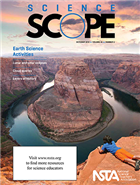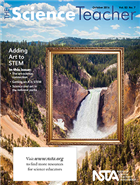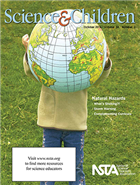Ideas and inspiration from NSTA’s October K-12 journals
By Mary Bigelow
Posted on 2016-10-13

The Four Strands of Science Learning and the Next Generation Science Standards from Science Scope is an informative article for teachers of any grade level.
Science Scope – Earth Science Activities
According to the editor, “Today’s students will become adults tasked with making decisions about environmental issues that will require a solid understanding of the Earth sciences.” And the Earth sciences are so interesting, too! If I were designing curriculum, Earth science would be the capstone course, integrating concepts from physics, chemistry, and the life sciences.
- The 5E lesson in Earth History Theories: Relative Age Dating Lab With Additions for Mining and Mineral Exploration integrates stratigraphy, age-dating, fossil and ore deposits as students make and use models of rock layers
- Exploring Lunar and Solar Eclipses Via a 3-D Modeling Design Task has a lesson idea to help students understand the phenomenon and dispel misconceptions.
- Teacher’s Toolkit: Puzzle Boxes for 3-D Learning About Natural Hazards describes how an observation activity can be adapted for in-depth discussions.
- Classic Lessons 2.0: Using Multiple Representations to Teach Science uses the example of moon phases to describe how to guide students through a sequence of concrete to abstract representations.
- Citizen Science: Clouds in the Classroom describes a project that’s been around for a while, gathering data from student observations—authentic science. And students investigate clouds in the classroom with the 5E lesson in Disequilibrium: Forming Clouds in the Classroom
- Earth science has many phenomena to explore, using the ideas in Teacher to Teacher: Phenomenal Engagement.
- Listserv Roundup: Finding and Saving Earth Science Resources lists additional resources on related topics.
- Science for All: Literacy Engagement and Its Role in the Science Classroom has resources for finding reading material appropriate for various student reading and interest levels.
- Scope on the Skies: Connected Computing describes how classrooms can contribute to authentic projects.
Articles that describe lessons include a helpful sidebar documenting the big idea, essential pre-knowledge, time, and cost.
For more on the content that provides a context for these projects and strategies see the SciLinks topics Clouds, Earthquakes, Eclipses, Layers of the Earth, Minerals and Rocks, Moon Phases, Natural Hazards and Disasters, Stratigraphy, Water Cycle.
 The Science Teacher – Adding Art to STEM
The Science Teacher – Adding Art to STEM
The featured articles in this issue focus on the overlap and integration of science and the arts (STEAM, as some call it). As the editor notes, “…science and the arts both spring from the same deep well of human creativity and imagination.”
- The Art-Science Connection has examples of the artwork create by students to communicate the results of their research and demonstrate their learning.
- The National Park Service turns 100 this year. Science and Art in the National Parks traces the history of the arts in the Parks and has suggestions for using them as inspiration for art and writing activities and a context for the sciences, such as geology. (Is it time to bring back the Federal Art Project from the 1930s?)
- Getting an A in STEM shows how chemistry and art can “cross-pollinate” using the concepts of chromotography, molecular structure, the Periodic Table,
- Sculpting the Barnyard Gene Pool illustrates how creativity doesn’t have to involve music or drawing. The interdisciplinary project focuses on engineering challenges and genetics. Likewise, designing investigations, as described in Measuring Metabolism, involves creativity and problem-solving.
- It may not be in the same arts league as dancing, but as Focus on Physics: Skateboard Physics shows, sports use physics creatively.
- Career of the Month: Acoustical Consultant describes how to use physics to create spaces for the performing arts.
For more on the content that provides a context for these projects and strategies see the SciLinks topics Acoustics, Cell Division, Chromatography, DNA, Genetics, Heredity, Homeostasis, Microscopes, Molecular Shapes, Periodic Table, Photosynthesis, U. S. National Parks.
 Science and Children – Natural Hazards
Science and Children – Natural Hazards
The featured articles this month describe how to tap into children’s interest in these phenomena, including the causes and how to protect ourselves. The lessons described in the articles include connections with the NGSS.
- Storm Warning challenges students to design, build, and structures that can withstand natural disasters.
- On a similar topic, What’s Shaking?! examines earthquakes through technology-based simulations. Students then design an earthquake-proof city.
- Science and social studies are Complementing Curricula in an integrated lesson on environmental science topics.
- Using direct and indirect evidence, students can observe, investigate, and analyze In Our Neighborhood: Who’s Been Here?
- The Early Years: Navigating Natural Disasters describes how children can be year-long weather watchers and includes a lesson on modeling how water moves and can be contained.
- The Poetry of Science: Hurricanes includes a poem to read aloud and discussion questions.
- Teaching Through Trade Books: Forecasting Hazardous Conditions has resources and 5E lessons for students learning about severe storms and hurricanes, including their causes and how to survive them.
- Science 101: What Causes Severe Thunderstorms and Tornadoes? has background information for teachers and activities on these topics.
For more on the content that provides a context for these projects and strategies see the SciLinks topics Adaptations, Earthquakes, Ecosystems, Erosion, Food Webs, Forecasting the Weather, Habitats, Hurricanes, Natural Disasters, Storms, Tornadoes, Water Cycle, Watersheds, Weather.
Disclaimer: The views expressed in this blog post are those of the author(s) and do not necessarily reflect the official position of the National Science Teaching Association (NSTA).


